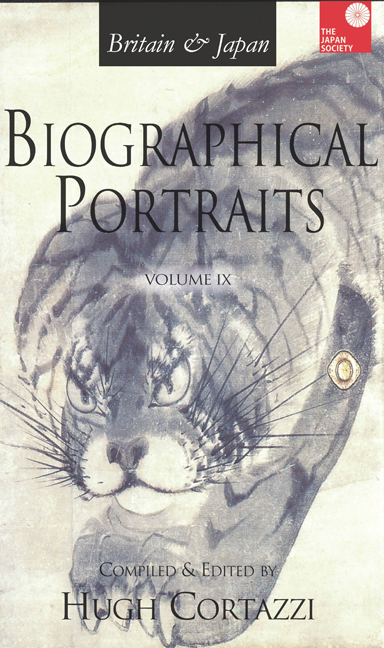Book contents
- Frontmatter
- Contents
- Introduction
- List of Contributors
- Index of Biographical Portraits in Japan Society Volumes
- PART I JAPAN IN BRITAIN: THINGS JAPANESE
- PART II BRITAIN IN JAPAN: TRADE
- BRITISH ACTIVITIES
- MISSIONARIES
- MUSIC, DRAMA AND FILM
- EPISODE
- PAINTERS
- JOURNALISTS
- JAPANESE WOMEN PIONEERS
- PART III SCHOLARS AND WRITERS: JAPANESE
- BRITISH
- PART IV POLITICIANS AND OFFICIALS: JAPANESE
- BRITISH OFFICERS
- BRITISH JUDGES AND A DIPLOMAT
- BRITISH POLITICAL FIGURES
- Index
35 - Mutō Chōzō (1881–1942), and A Short History of Anglo-Japanese Relations
Published online by Cambridge University Press: 30 April 2022
- Frontmatter
- Contents
- Introduction
- List of Contributors
- Index of Biographical Portraits in Japan Society Volumes
- PART I JAPAN IN BRITAIN: THINGS JAPANESE
- PART II BRITAIN IN JAPAN: TRADE
- BRITISH ACTIVITIES
- MISSIONARIES
- MUSIC, DRAMA AND FILM
- EPISODE
- PAINTERS
- JOURNALISTS
- JAPANESE WOMEN PIONEERS
- PART III SCHOLARS AND WRITERS: JAPANESE
- BRITISH
- PART IV POLITICIANS AND OFFICIALS: JAPANESE
- BRITISH OFFICERS
- BRITISH JUDGES AND A DIPLOMAT
- BRITISH POLITICAL FIGURES
- Index
Summary
INTRODUCTION
MUTŌ CHŌZŌ was the author of A Short History of Anglo-Japanese Relations (1936), the first brief history of Anglo-Japanese relations. He came from Aichi prefecture1 but worked mainly in Nagasaki and is one of the three most prominent pre-war Nagasaki scholars. His name is not well-known these days in either Japan or Britain. However, his book was a pioneering work in its field and was considered a good introductory text for students new to the subject despite its somewhat antiquated style. It is inevitably out of date.
CAREER
Mutō Chōzō was born on 9 June 1881, in Umibe-gun, Tsushima-chō , which is now Tsushima city in Aichi Prefecture. He was the second son of Mutō Chōhachi. Chōzō also had an older brother, Chōhei who, like Chōzō, had a scholarly bent and became a teacher at a high school in Hiroshima.
In April 1893, Mutō entered the Nagoya Commercial High School in Nagoya city. He graduated in 1897, and went on to study at the Tokyo Commercial High School, which later became part of Hitotsubashi University. He graduated in 1905 and was appointed to teach at the Tōadōbunshoin (East Asian Literary School) in Shanghai, which later became the forerunner of Aichi University. This was the beginning of his lifetime career as an educator and a scholar.
In 1907, Mutō was given the post of professor at Nagasaki Higher Commercial School, a post that he retained until his death in 1942. The school was eventually closed in 1951, and what has become known as the Mutō Collection (Mutō. Bunkō.) of books and other resources were later incorporated into the library at the Department of Economics, Nagasaki University.
Mutō was able to travel for his research. In 1909, he spent time once again in China and then in Korea. In 1910, when, the Japan- British Exhibition was taking place in London, he was working between Tokyo and Nagasaki carrying out research. In 1911, the year in which the third Anglo-Japanese Alliance was signed, he went to the United States, Britain and Germany for a period of three years further study. At that time British attitudes towards Japan were generally positive.
In Germany, Mutō studied at Freiburg University under economics scholars such as Gerhart Von Schulze-Gaevernitz (1864–1943) and Robert Liefmann (1874–1941).
- Type
- Chapter
- Information
- Britain & Japan Biographical Portraits Vol IX , pp. 406 - 412Publisher: Amsterdam University PressPrint publication year: 2015

